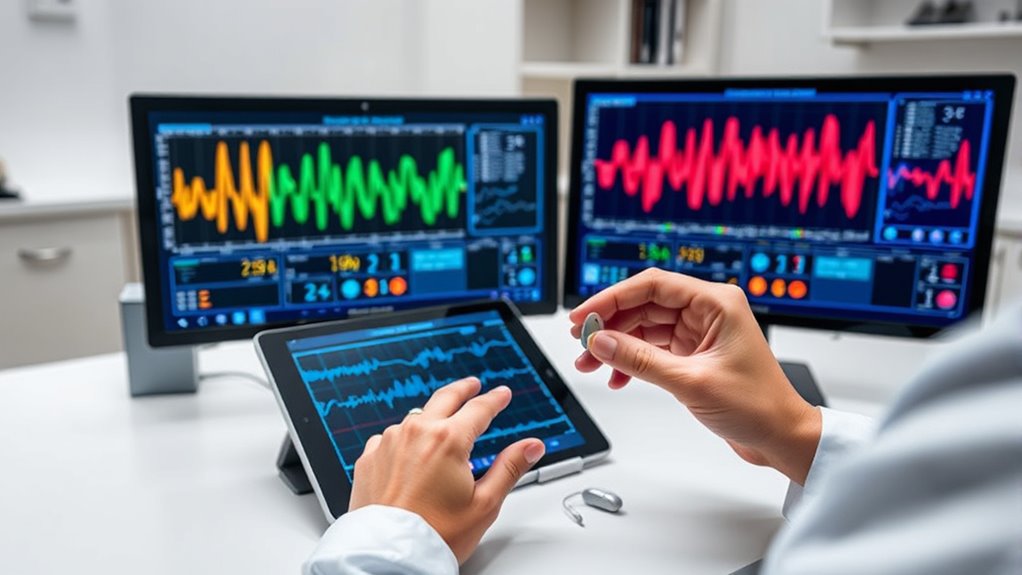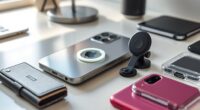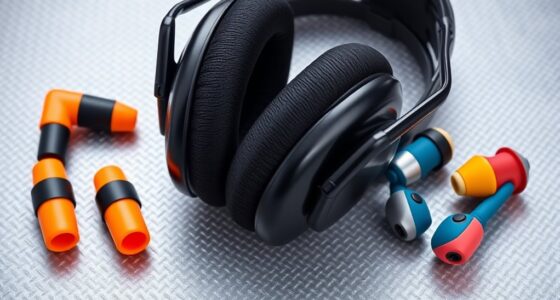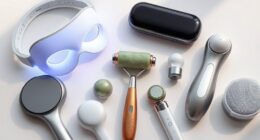Teleaudiology and remote programming let you manage your hearing aids and get audiology services from home through secure video calls and digital data sharing. You can receive adjustments, troubleshoot issues, and update your devices without visiting the clinic. These services use user-friendly platforms that guarantee your privacy and security. As technology keeps improving, remote care becomes more reliable and effective. Keep exploring to discover how these innovations can enhance your hearing health experience.
Key Takeaways
- Teleaudiology allows hearing care services, including device adjustments, to be delivered remotely via secure video calls and data sharing.
- Remote programming enables audiologists to fine-tune hearing aids from a distance, improving convenience and timely care.
- Technology advancements ensure secure, private communication, protecting patient information during remote audiology sessions.
- Remote services enhance accessibility for patients in rural areas or with mobility challenges, promoting ongoing hearing health management.
- Future developments aim to make remote audiology more reliable and integrated, expanding personalized hearing care options.
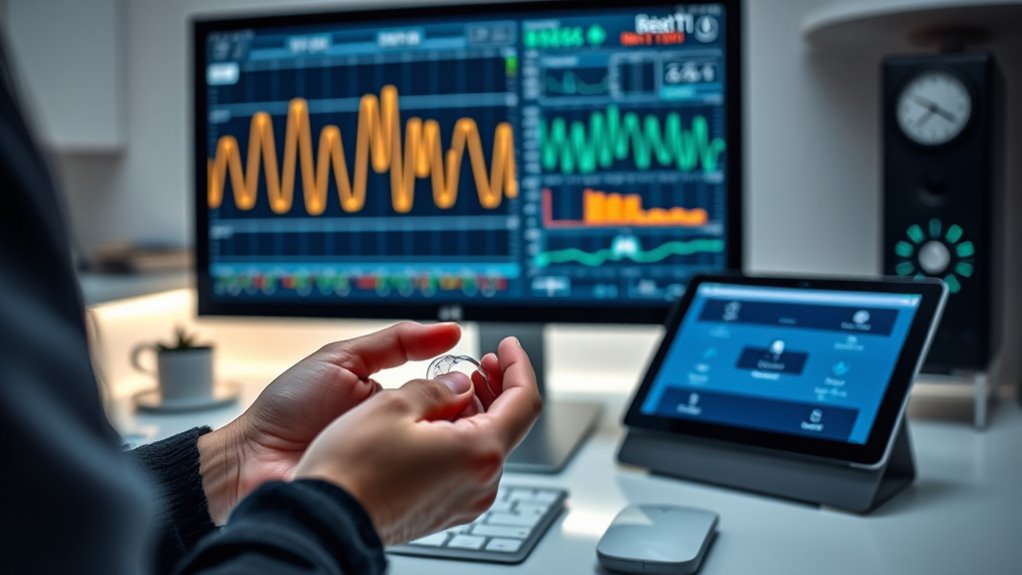
Teleaudiology and remote programming are transforming how you access hearing care, making it more convenient and efficient. Instead of traveling to a clinic, you can now receive expert audiology telehealth services from the comfort of your home. This approach leverages modern technology to perform tasks like remote fitting, where your hearing aids are adjusted and fine-tuned without an in-person visit. With remote fitting, audiologists can assess your hearing needs, make necessary modifications, and send updates directly to your devices. This process saves you time and reduces the inconvenience often associated with traditional appointments.
Through teleaudiology, your audiologist can guide you step-by-step on how to use your hearing aids, troubleshoot issues, and guarantee your devices operate at their best. This method not only enhances accessibility but also allows for more frequent check-ins, which can lead to better hearing outcomes. Audiology telehealth platforms are designed to be user-friendly, often providing secure video calls, remote data sharing, and real-time communication. This setup enables quick and effective adjustments, all while maintaining high standards of care. Additionally, advancements in technology continue to improve the quality and security of remote communication, ensuring your privacy and satisfaction.
Teleaudiology offers easy access, frequent check-ins, and high-quality, real-time hearing aid support at home.
Remote programming plays a vital role in this evolving landscape. It involves updating and customizing your hearing aids remotely, based on your feedback and audiometric data. Instead of scheduling multiple in-person visits, your audiologist can perform these adjustments remotely, often within minutes. This flexibility ensures you get personalized care promptly, especially if you’re in a rural area or have mobility challenges. You simply need a compatible device, a stable internet connection, and some basic instructions, and your audiologist can access your hearing aids remotely through secure software.
The benefits of remote fitting and audiology telehealth extend beyond convenience. They also promote ongoing management of your hearing health, allowing for continuous monitoring and adjustments as your needs change. Plus, these services foster a more proactive approach to hearing care, catching issues early and ensuring your hearing aids are always maximized. As technology advances, the quality and reliability of remote programming will only improve, giving you more confidence in managing your hearing health from a distance. Embracing innovations like remote audiology can significantly enhance your overall experience and outcomes.
Frequently Asked Questions
How Secure Is Patient Data During Remote Audiology Sessions?
During remote audiology sessions, your patient data remains secure because providers prioritize patient privacy and use strong data encryption. These security measures protect sensitive information from unauthorized access and cyber threats. You can feel confident that, with proper protocols in place, your patients’ data is kept confidential throughout the session. Regular updates and compliance with privacy regulations further strengthen the security, ensuring their information stays safe at all times.
What Equipment Is Necessary for Effective Teleaudiology Services?
You need reliable wireless connectivity and diagnostic tools for effective teleaudiology services. Make certain your devices, like computers or tablets, have high-speed internet to support seamless sessions. Use specialized diagnostic tools compatible with remote software to accurately assess hearing issues. A good quality microphone and camera enhance communication, while secure data transmission protocols protect patient information. These essentials enable you to deliver accurate, efficient remote audiology care.
Can Remote Programming Fully Replace In-Person Audiology Appointments?
Remote programming can’t fully replace in-person appointments, despite the convenience of current technology. While remote technology enhances patient engagement and provides effective adjustments, some assessments and delicate diagnostics still require face-to-face contact. Hands-on help ensures precision, personal connection, and thorough care that remote methods can’t fully replicate. So, for now, combine remote convenience with in-person expertise for the best audiology outcomes.
How Do Licensing Regulations Affect Teleaudiology Practices Across States?
State licensing rules greatly impact your teleaudiology practice, especially when it comes to cross border practice. You must obtain licensing in each state where your patients are located, which can be complex and restrictive. These regulations ensure quality and safety but may limit your ability to provide remote services across state lines. Staying updated on licensing requirements helps you navigate legal hurdles and expand your teleaudiology reach effectively.
What Are the Common Technical Issues Faced in Teleaudiology?
You often face technical issues like connection stability problems, which can disrupt sessions, and hardware compatibility challenges, making it hard to guarantee equipment works seamlessly. To minimize these issues, check your internet connection regularly and use compatible devices recommended by your teleaudiology platform. Keeping software updated and troubleshooting hardware beforehand ensures smoother consultations, so you can provide effective care without unnecessary interruptions.
Conclusion
Teleaudiology and remote programming are transforming hearing care, making it more accessible and convenient. Did you know that over 85% of hearing aid users report improved satisfaction with remote services? By embracing this technology, you can enjoy quicker adjustments and better support from the comfort of your home. As advancements continue, you’re empowered to take control of your hearing health, ensuring a better quality of life without the need for frequent clinic visits.

